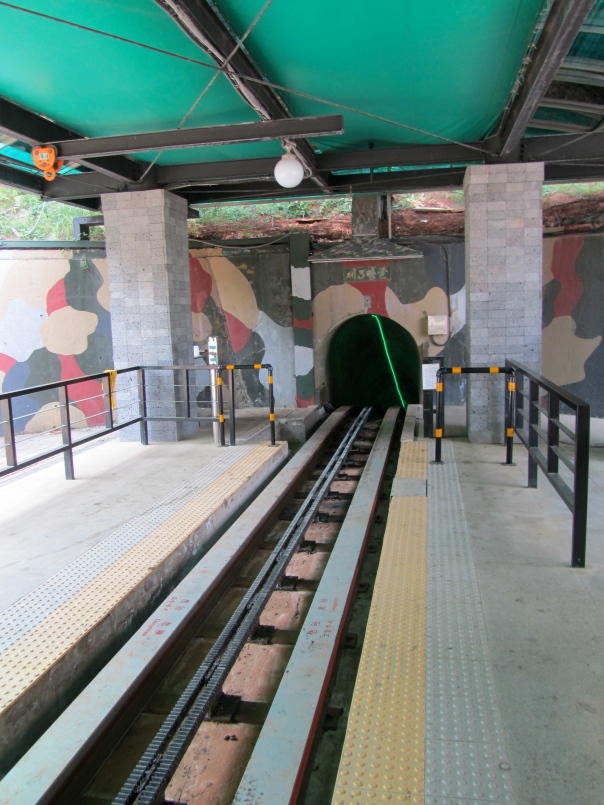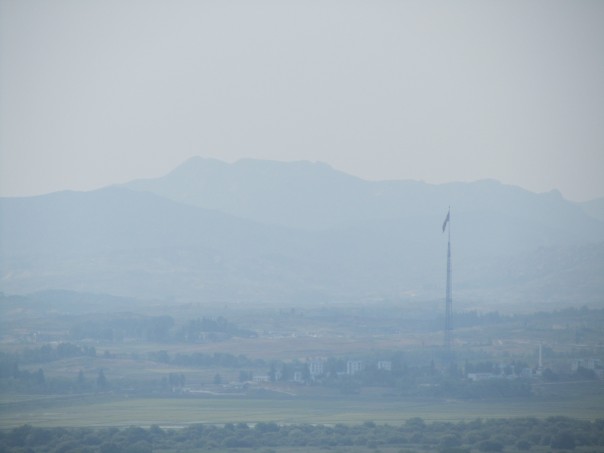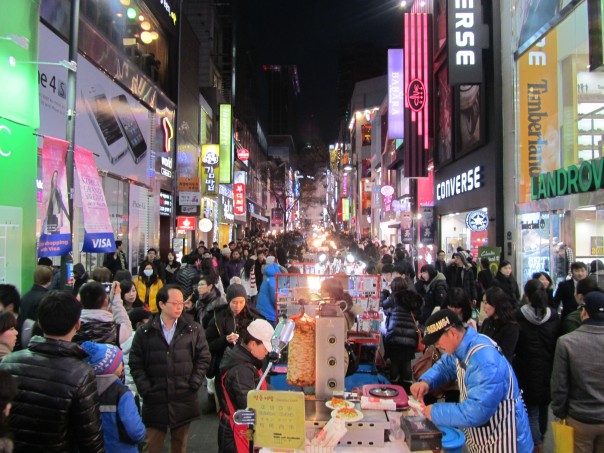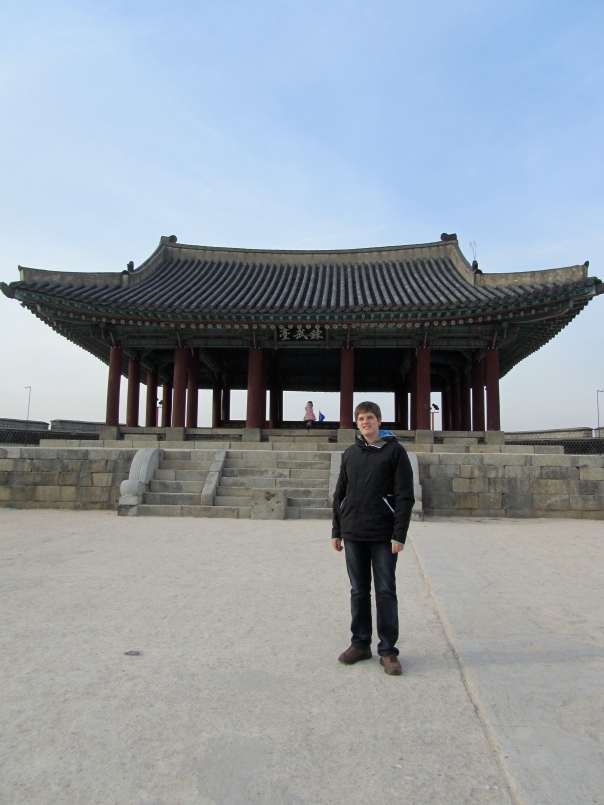Blog Archives
비무장 지대 여행 | DMZ Trip
This past weekend, we went on our final Rotary-sponsored trip to see Korea. For this trip, I was able to see a very important piece of Korea’s modern history. This place was the DMZ (The De-Militarized Zone), which acts as the tense barrier between North and South Korea. This one place is what comes to mind first for many when they hear about Korea, so I really wanted to take the chance to see such an important part of the country.
Mrs. Kim, our Rotary Officer, and her husband, the Principal of our school, joined us for the trip, so we went in their car to 임진각 (Imjingak), a park near the border where the tour bus would depart from. Around the ticket window, there were quite a few monuments, and strangely a carnival. We only looked around for a short time before our bus arrived, and we went off to the first portion of our tour, seeing one of the tunnels that was built by North Korea as part of an infiltration plan. We took the tram car down to the area that the third tunnel was in, and from here, we were able to walk quite a distance down the tunnel to the first of three walls built to prevent use of the tunnel past the actual DMZ line by North Korea. The tunnel was very cramped, so I was not alone in my needing to bend down in order to walk through. The alarming thing to me about this tunnel to me was that it was only discovered because of a tip given by a North Korean defector who knew about it. Apparently, the workers had even put black paint on the walls to try disguising it as a coal mine.
The tour buses ran on a tight schedule, so we had just returned from underground, when they hurried us back onto the bus and off to our next stop, 도라전망대 (Dorasan Observatory), where we would be able to catch a glimpse of 개성시 (Gaesung City) and the surrounding farmland. This city is considered to be somewhat of a fake city set up by the North Korean government, where few people actually live, but it is staged to show a more wealthy style of living. Using one of the coin operated binoculars, I was able to see only a few cars and people working in the field. The striking feature though is the gigantic flag pole that towers above part of the city, echoing a smaller one on the other side of the border set up by South Korea. At this point, we could only take pictures from behind a specific point, but thanks to a good zoom on my camera, I was able to capture a few good pictures, but not as many as I would have liked before we had to head back to the bus. This part of the tour was definitely the most interesting to me, as it really was very different to think of North Korea as a place than it was to actually see the country.
We made one more stop during our tour in order to see 도라산역 (Dorasan Station), which is the final station on the South Korean side of a rail line built to connect the two countries. Unfortunately, shortly after being built the peace talks that had allowed its construction connecting through to Pyeongyang, was not enough to get it so that trains would run. So, instead, this station sits unused. If the connection could eventually be used, though, it would certainly be important, as it would create a connection that would allow one to travel by rail all the way from South Korea to Portugal, completely crossing both Europe and Asia.
When we got back to Imjingak, where our tour bus departed, we went by car to Seoul, where we would spend the night. The next day, the major thing that we did was visiting 남대문 (Namdaemun), one of Seoul’s Market Areas, so that we could do some souvenir shopping. Mrs. Kim and the Principal had to head back to Seocheon early, so it was just the exchange students for the day, and from our experience from past trips, we easily made our way home on the train after the interesting trip.
수원하고 서울 | Suwon and Seoul
Last weekend, I went to Suwon to visit Sejin, one of the counselors I met at 숲속의 호수 (Sup Sogui Hosu), the Korean Camp at Concordia Language Villages. While there, I also got to see a lot of the city of Seoul, which I considered my first real visit to the city, because I had only seen a museum there during my first visit to the city. Upon visiting it, I felt that Seoul was definitely one of my favorite cities in the world.
To go to Suwon, I took the train from Gunsan. For me, the train ride was already an interesting experience, because it isn’t really a travel option for me in the United States. I have taken trains before, but never as the only mode of transportation for a trip and also never alone. It was not too difficult to do the trip though, because I only had to take one train and get off at the correct stop. In Suwon Station, I met with Sejin and we took the bus over to his apartment so that I could leave my bag there. After having lunch with him and his wife, I was going to be spending the day in Seoul. To get there, Sejin and I took a bus from Suwon to Seoul. It was a long trip, but Sejin had a movie on his computer that we watched.
Once in Seoul, we got onto the Subway and went to Insadong, which is a district of the city that has many more traditional shops. Where we first walked into the main street, a large crowd had gathered around a group performing traditional dance. They were wearing masks and were accompanied by musicians playing the traditional Samulnori instruments. From there, we walked down the street, looking at the many shops. One of the most memorable for me was a large tea shop that had free samples of their tea from Jeju Island. We got into the line that had formed inside the shop and had some of the best green tea I have ever tasted.
From the market, we walked a few blocks away to wander the streets of the Bukchon Hanok Village. A hanok is a traditional Korean house, and this area was notable for the sheer quantity of them being preserved in one place. It was interesting to see the beautiful architecture of the houses in this part of the city. While we were looking around, there was a Chinese travel show that was also filming in the area, so there is a possibility that we might have made it onto Chinese television.
After seeing the Hanok Village, we walked over to the National Folk Museum at Gyeonbokgung. It was part of a large complex around Gyeonbokgung Palace. We looked at some of the buildings in the area that we didn’t have to pay for, as I might be going back to see the Palace during the Rotary-sponsored Seoul Trip that I will be taking later in the month. From there, we walked by Gwanghwamun, the Gate to the Palace, and over to Cheonggyecheon, which is a reclaimed stream that goes through part of the city. Along the stream, they had walkways, bridges, art, and greenery that made it into an interesting walk.
We turned off from Cheonggyecheon after a few blocks, and we went to Namdaemun Market, which is one of the busiest market districts in Seoul. It was rather overwhelming, because there were people everywhere. Our major stop here was to get dinner. We went to a noodle shop, named 명동교자, that had extremely good food and was apparently rather well-known. When we went in, the restaurant was rather crowded, but we were able to get a spot very quickly, but when we were leaving, the line stretched out the door.
Once we left Namdaemun Market, we took a cab to Namsan Mountain to see the North Seoul Tower (also called Namsan Tower). To get up the mountain and to the tower, we climbed up the stairs instead of taking the cable car that most people take, which has a very long wait. As soon as we reached the tower, they announced that they would be starting the tower light show, so we sat down, and watched the light show that was projected onto the Tower. We were extremely happy with our good timing to see that show. Although we didn’t go up to the observation deck on the tower, we admired the view and the attractions around the base of the tower. One of the most interesting of these attractions is the many locks that are attached to the fence on part of the viewing space on the top of the mountain. The reason for these are that couples will write a love message on a lock, attach it to the fence, and then throw the keys for the lock over the fence. After we finished at Namsan Tower, we took a bus to get back down. Because of the large demand to go up and down the mountain, the bus was one of the most crowded that I have been on. When we got down from the mountain, we took the bus back to Suwon and went to bed very tired.
The next day, I went with Sejin and his wife to pick up their kids from their Grandparents house in a nearby city. I spent most of the day with the whole family. We did not do as much on this day, because I was very tired, but I got to see more of the city of Suwon. We visited one of Suwon’s major attractions, Hwaseong, a fortress wall that extends around the main part of the city. Here, I walked around part of the wall with Sejin and his daughter. It was interesting to see the ties to all of Korea’s history still being visible in a major way. Most of that day, I got to spend with Sejin and his family, which was something that I really appreciated, but the next morning I had to take the train back to Gunsan.










